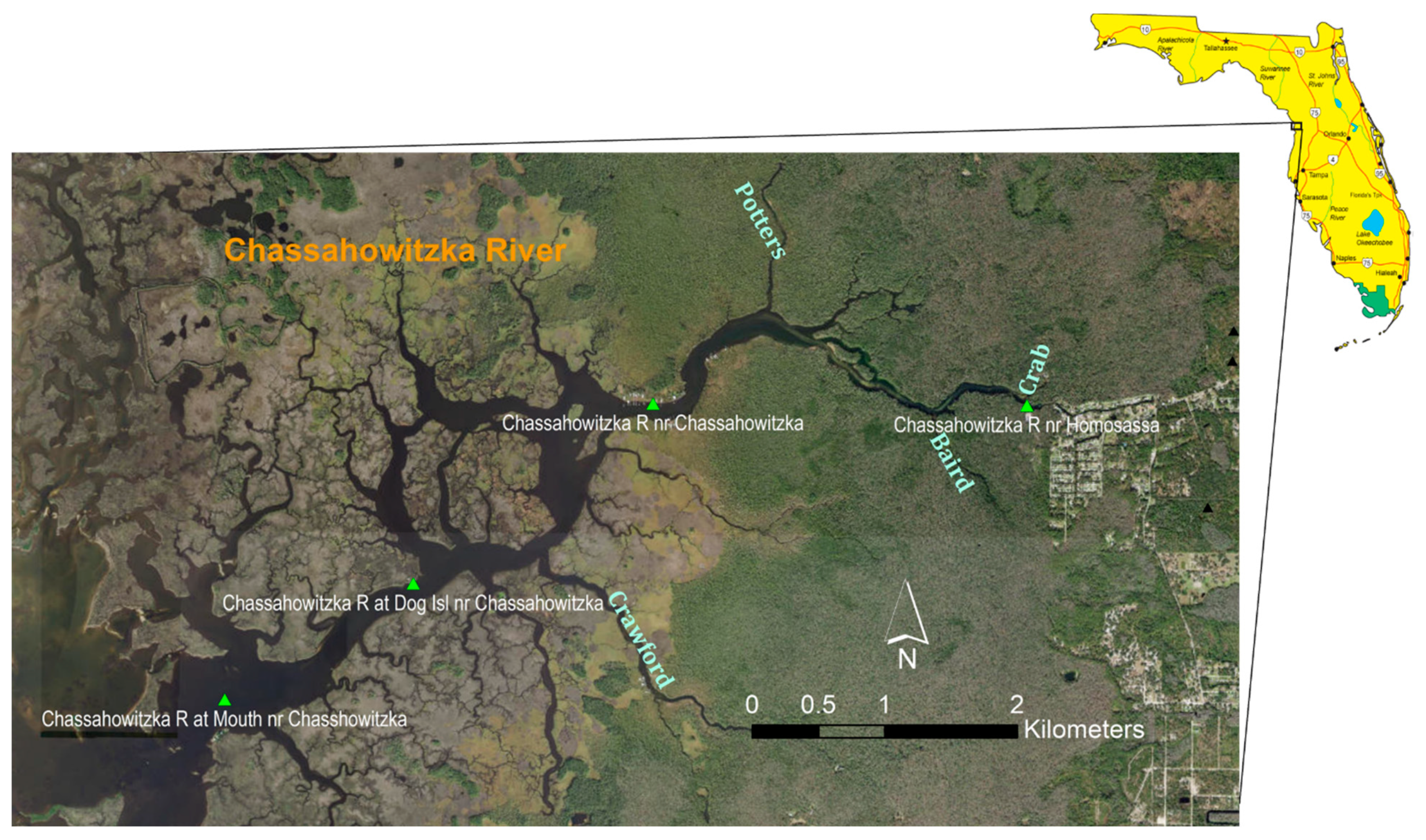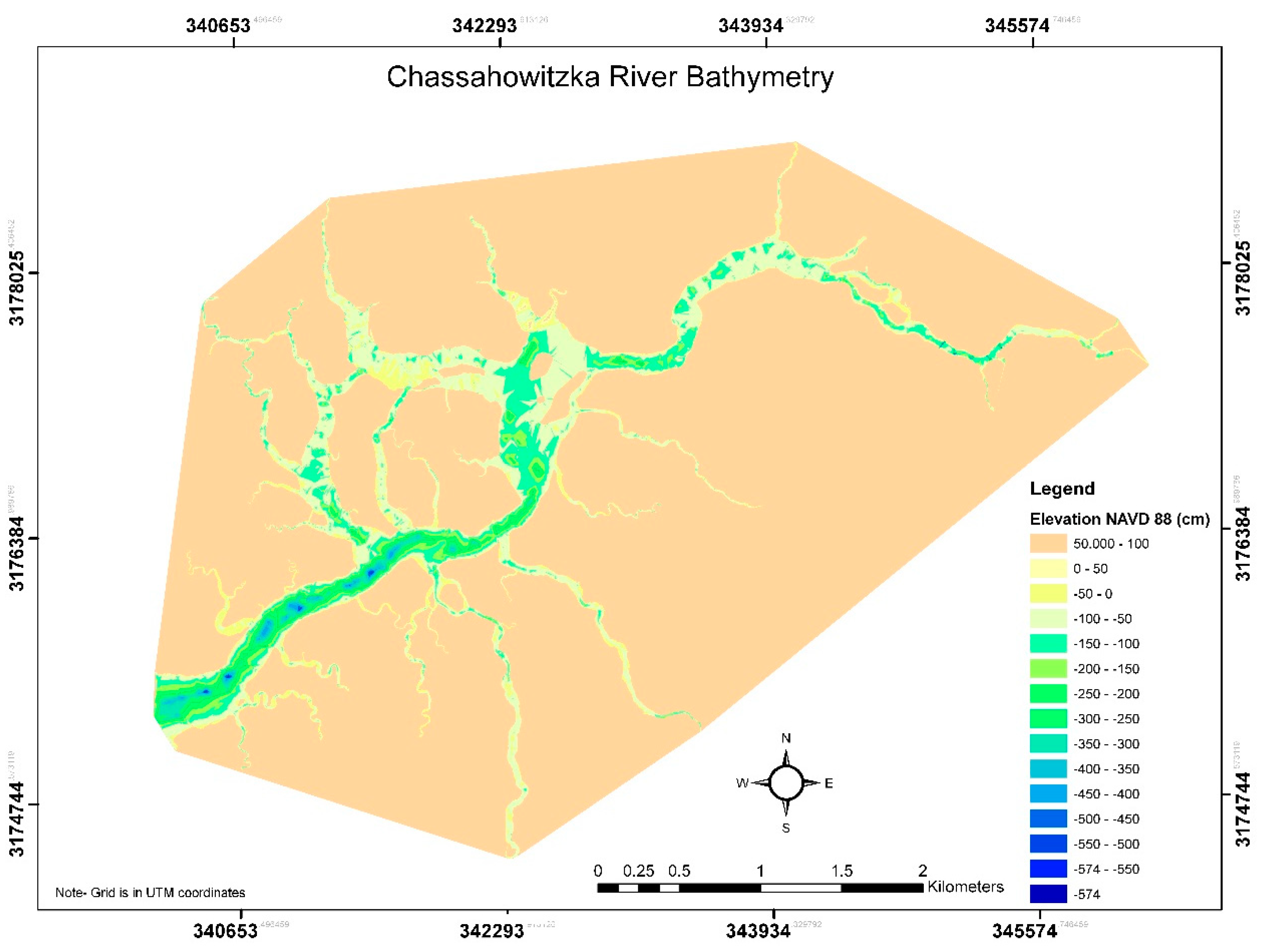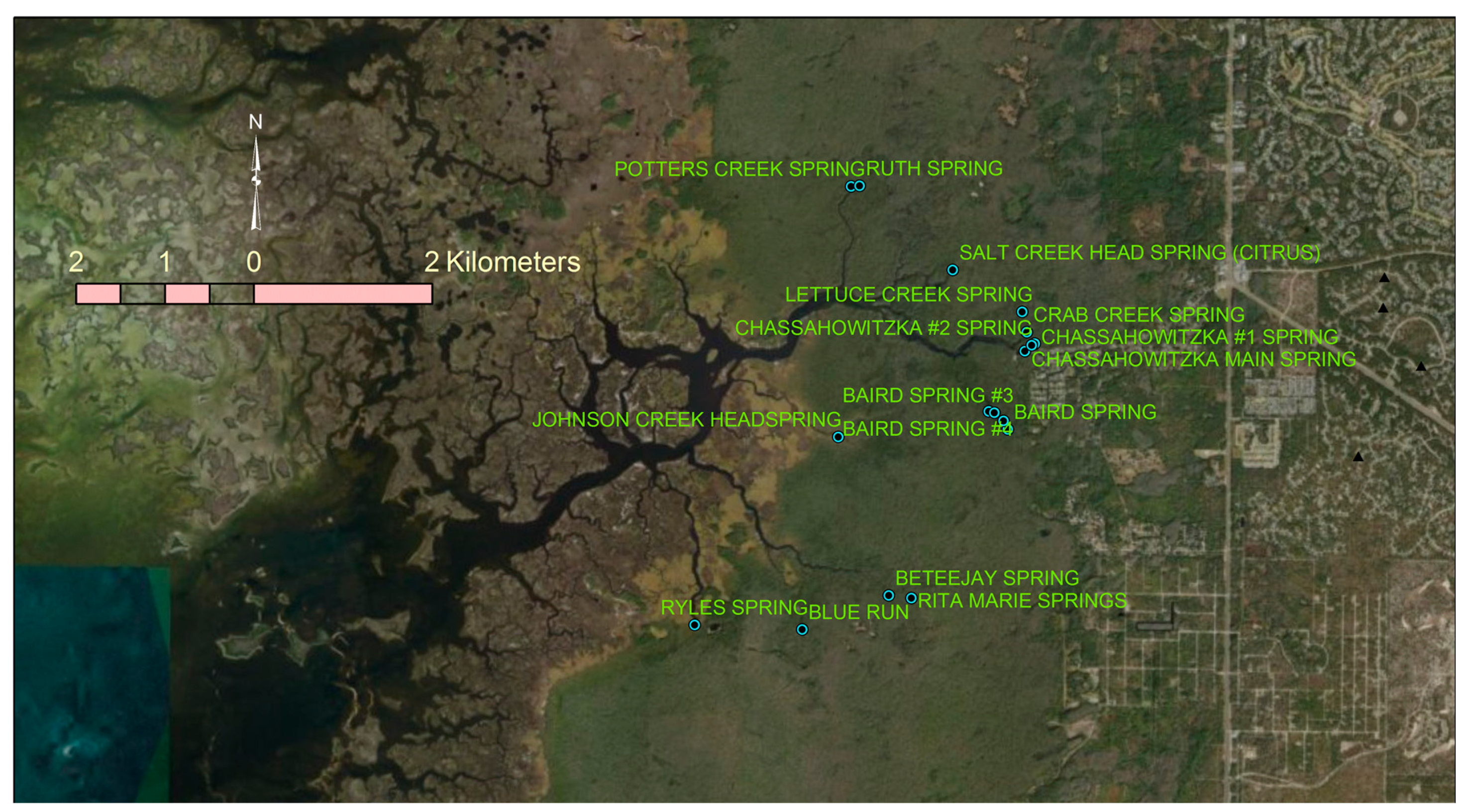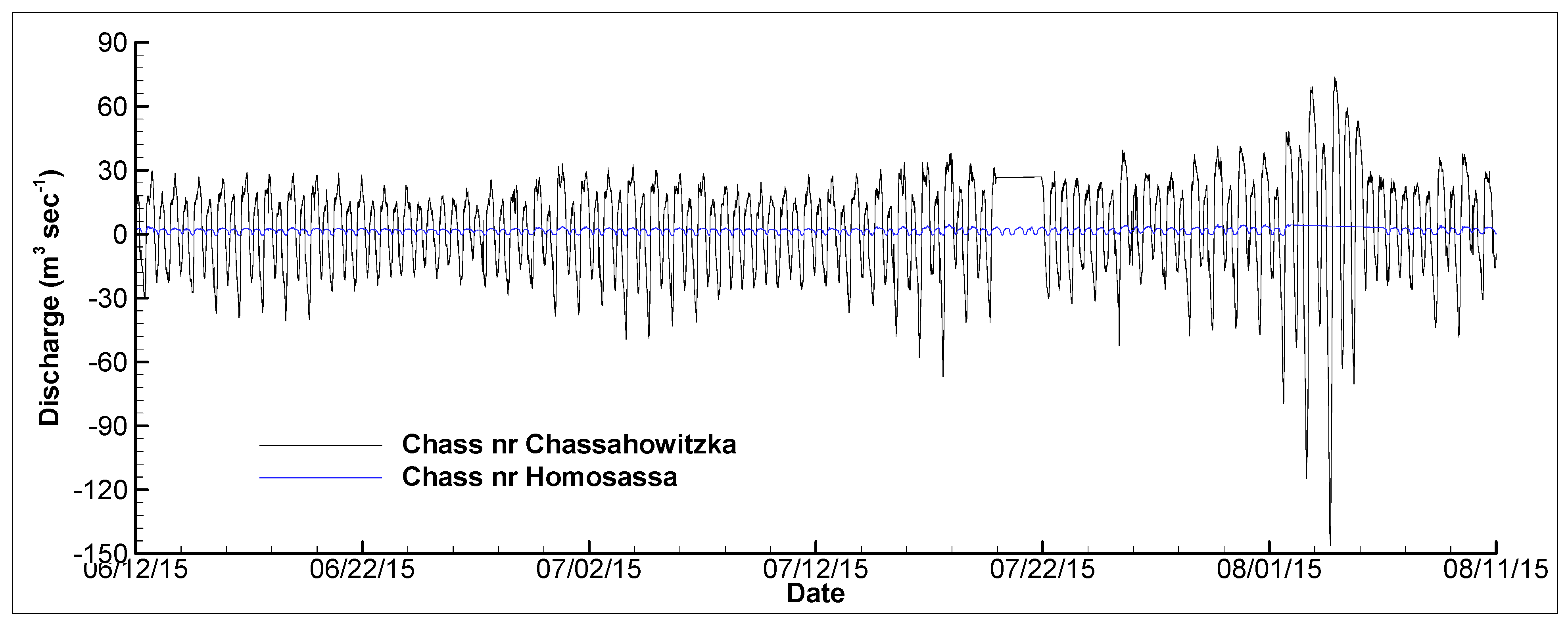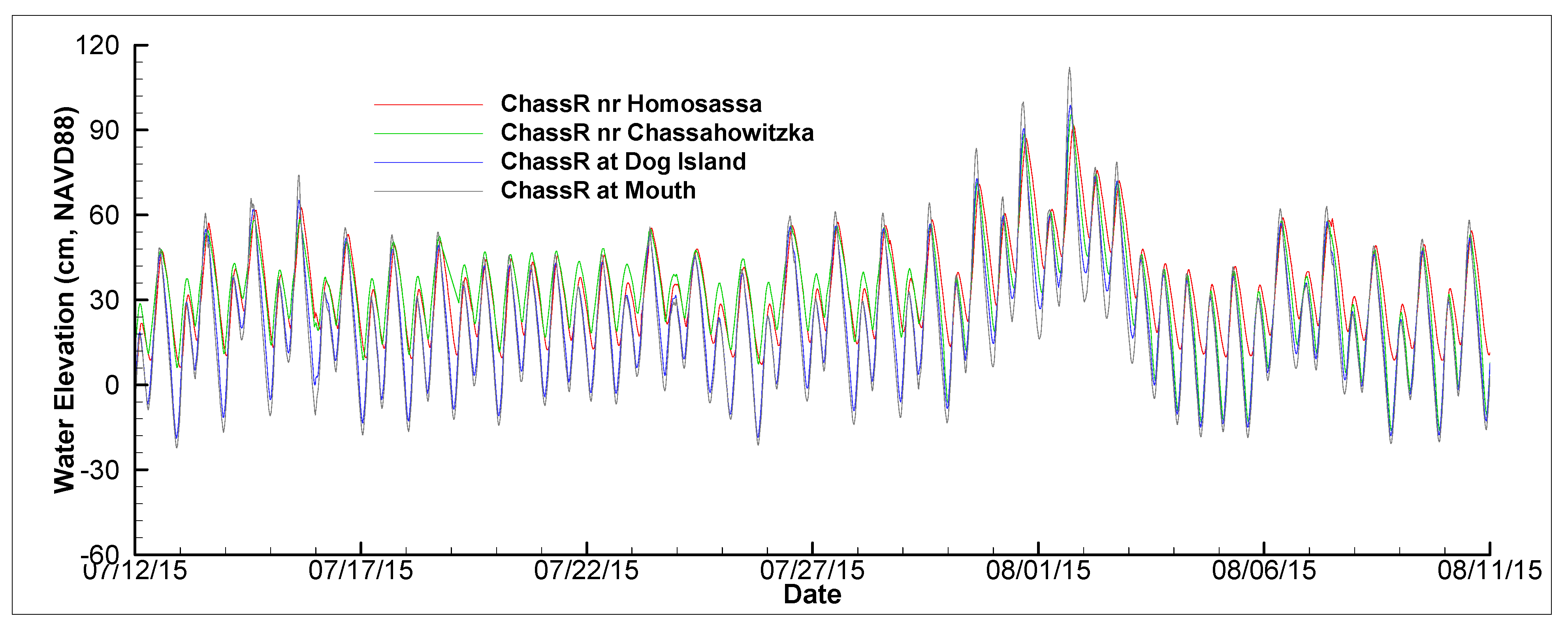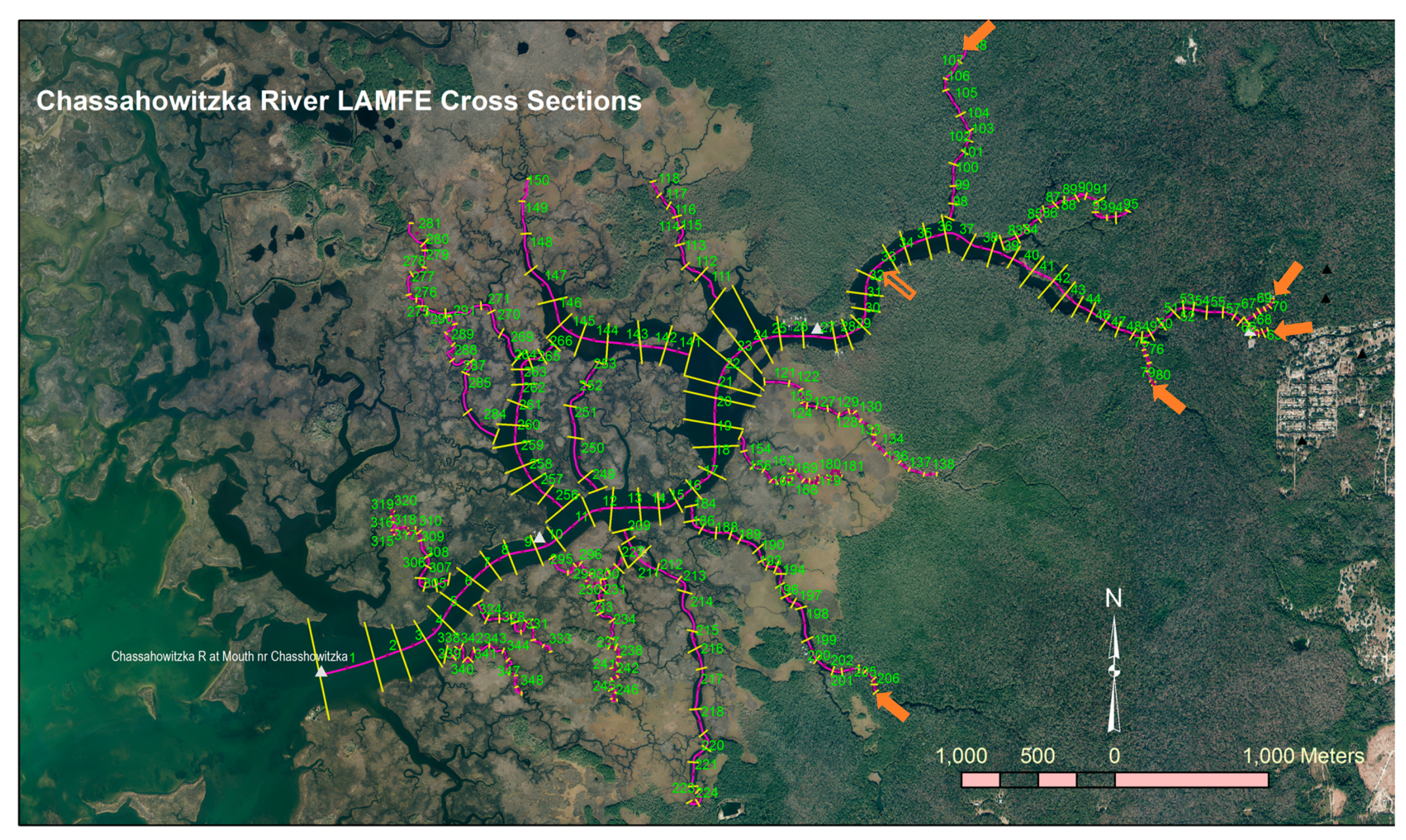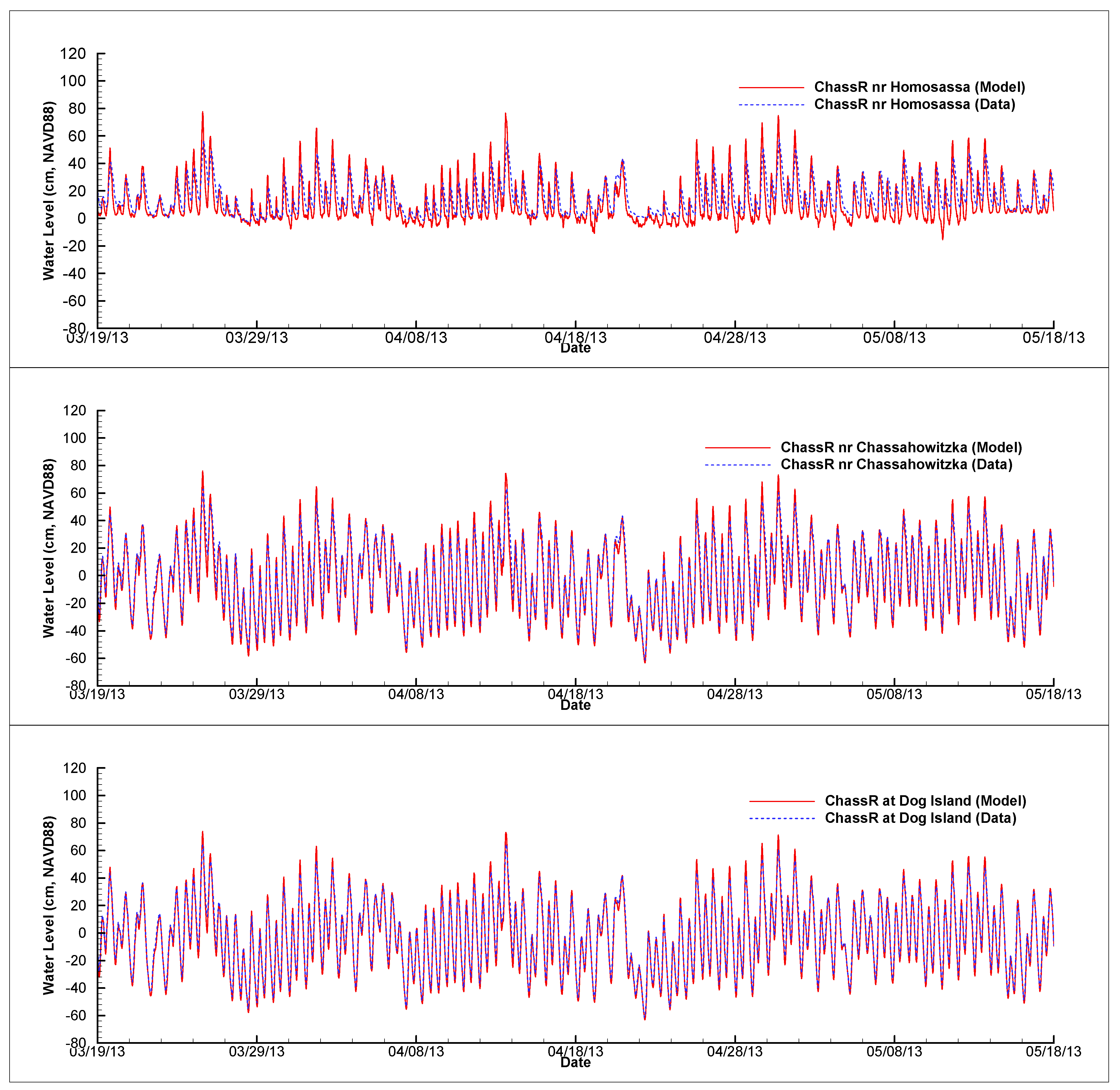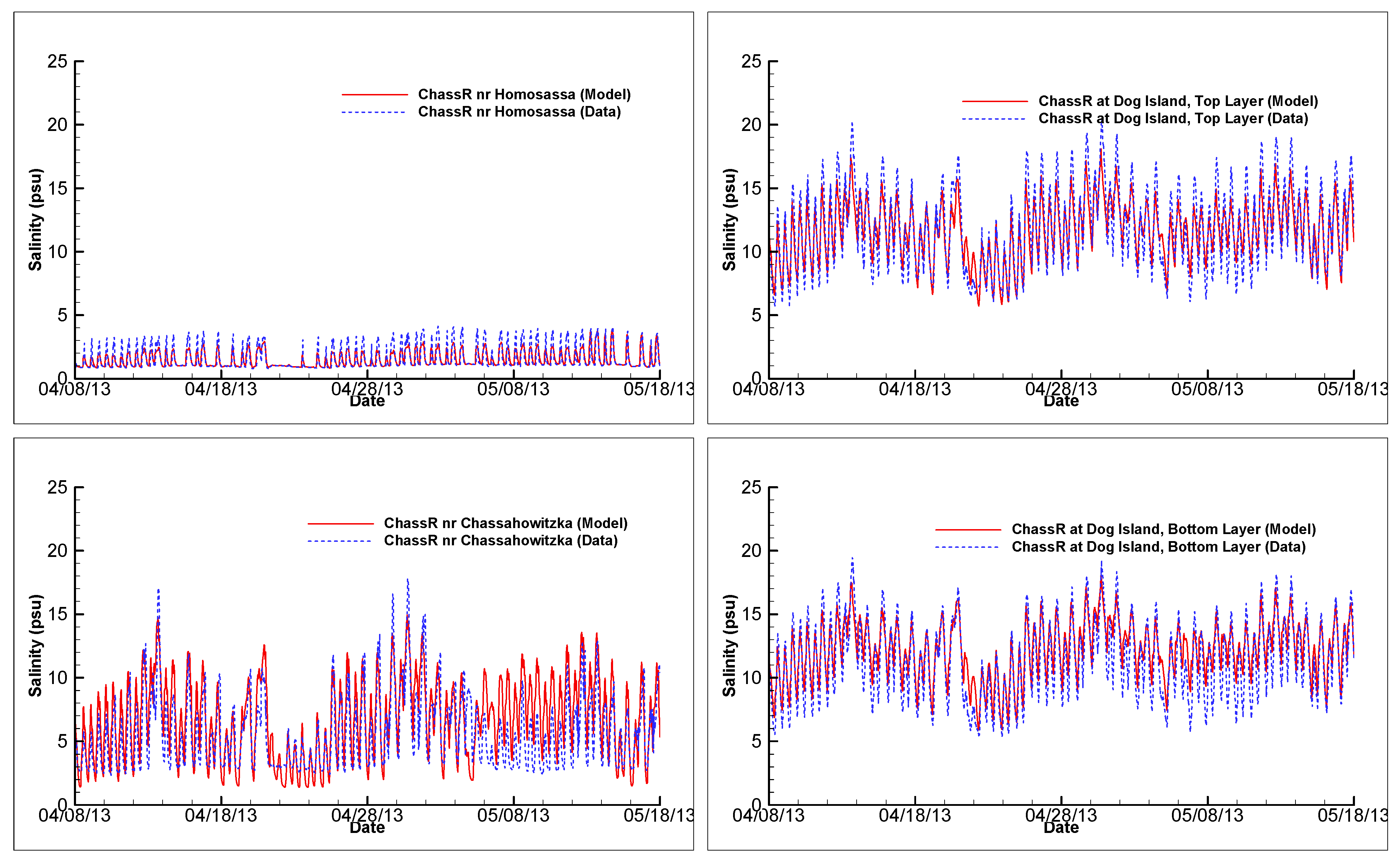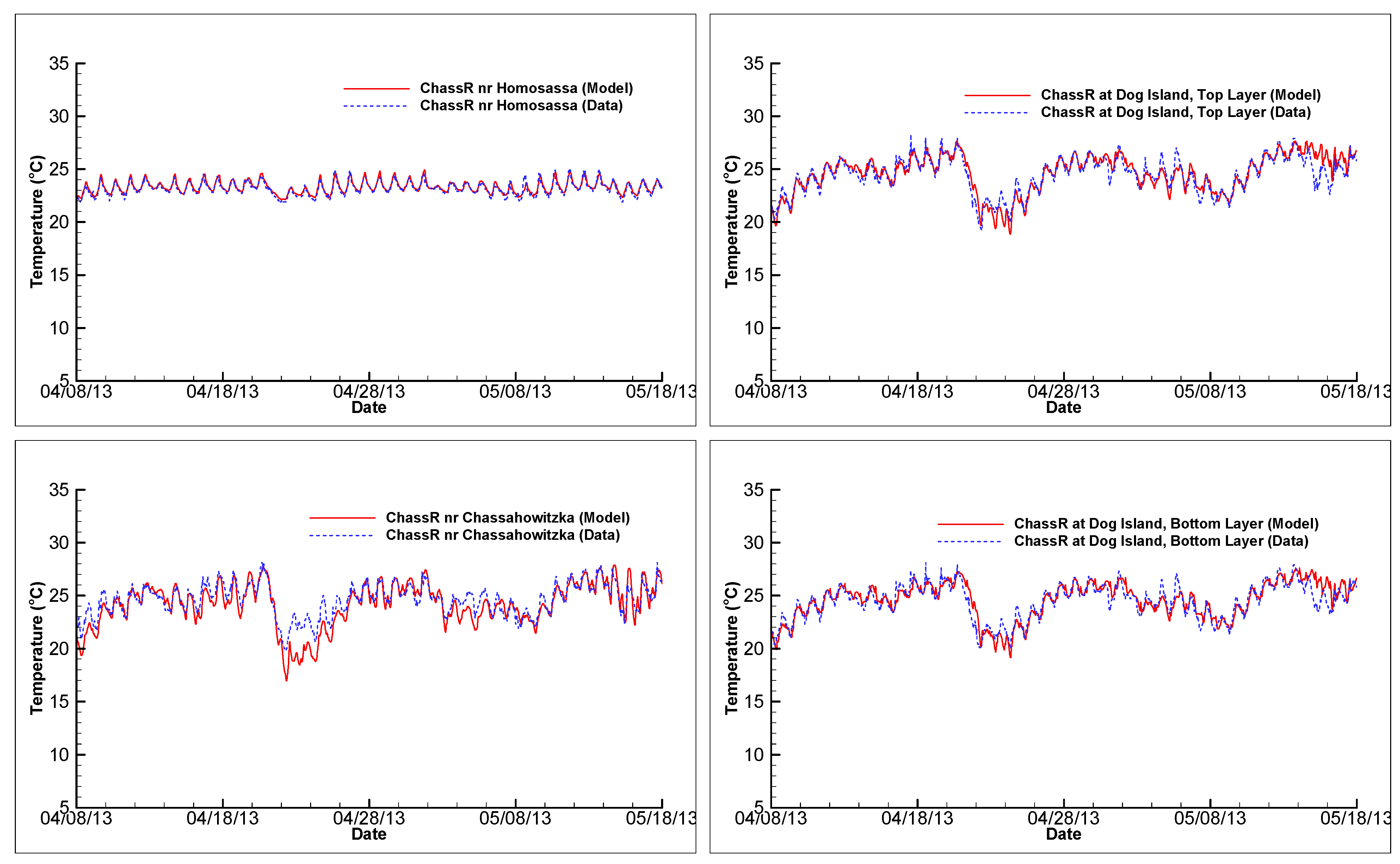1. Introduction
Located on the Gulf Coast of the Florida peninsula, the Chassahowitzka River is a spring-fed estuary (
Figure 1). The river is shallow and narrow and barely receives any surface water runoff from its 230 km
2 watershed. Hydrologic loadings to the Chassahowitzka River mainly come from its contributing groundwater field, or springshed, in the form of submarine groundwater discharges from a number of spring vents, which can be found at its headspring area and in several of its tributaries. The springshed is delineated based on the potentiometric contours in the region in a way similar to that used in the watershed delineation. Unlike a watershed, which generally has a stable shape and size, a springshed can vary slowly with time, because the potentiometric contours are affected by rainfall, which varies with time. For the spring flows entering the Chassahowitzka River estuary, the area of the springshed is estimated to be about 492 km
2, more than double the size of its watershed.
The Chassahowitzka River is a shallow and well/partially mixed estuary. Many marine species such as Common Snook (
Centropomus undecimalis) and Florida manatees (
Trichechus manatus latirostris) use the river as thermal refuges in winters, because the estuarine system receives a large and relatively stable rate of warm SGD with a temperature of about 23 °C. Protecting thermal habitats in the Chassahowitzka River is ecologically critical to the estuarine system and economically important to local communities. The region is well-known for manatee-related tourism, which attracts millions of visitors to the Gulf Coast of Florida. To protect this ecologically valuable springs/estuarine system, a minimum spring water flow rate was established [
1] and recently re-evaluated by the Southwest Florida Water Management District [
2].
Physical processes such as circulations, salinity transport processes, and thermal dynamics in the Chassahowitzka River estuary have never been thoroughly studied before and there exists very limited effort on hydrodynamic modeling of the estuary in literature. Dynamic Solutions [
3] used the 3D model EDFC, or the Environmental Fluid Dynamics Code, developed by Hamrick [
4] to simulate hydrodynamics in the Chassahowitzka River estuary. They discretize the riverine estuary with a typical grid size of 50 m by 80 m in the horizontal plane and four σ layers in the vertical direction. Due to the relatively coarse grids used in the simulation, their modeling study could not reasonably resolve the bathymetric variations in the estuarine system in many river segments, especially in the upstream narrow area as well as the tributaries and distributaries. The EDFC model for the Chassahowitzka River estuary was calibrated for a four-month period from November 2006 to February 2007 [
3], basically only for the cold months of the year when the SGD entering the system was the lowest. Although the EFDC model was calibrated against measured real-time data of water elevation, salinity, and temperature at two stations, there was no verification of the model.
Similar to many other narrow riverine estuaries such as the lower Alafia River Estuary [
5], Tanshui River estuary [
6], as well as the lower Peace River and tidal Caloosahatchee River in the Charlotte Harbor estuarine system [
7], the transversal variations of flow, salinity, and temperature in the Chassahowitzka River estuary are much smaller than those in the longitudinal and vertical directions due to its narrowness. As a result, circulations, as well as salinity and temperature distributions in the Chassahowitzka River, are generally vertically two-dimensional, a typical flow pattern for narrow estuaries [
8,
9,
10]. The most suitable hydrodynamic model for the Chassahowitzka River is a laterally averaged (2DV) model such as the LAMFE model [
11]. One advantage of a 2DV model in dealing with the complexity of the braided riverine system is that the wetting and drying phenomenon can be simulated automatically and accurately, simply because the river width is included in the governing equations as a variable (please see
Section 3). The LAMFE model has another advantage over other hydrodynamic models such as the EFDC mode: It runs very fast and thus allows several years of simulation to be done in a couple of hours. The very short running time of the LAMFE model is not only due to a reduced dimension but also due to the use of an efficient semi-implicit scheme named the free-surface correction (FSC) method [
11]. The FSC method is unconditionally stable with respect to gravity waves, wind and bottom shear stresses, and vertical eddy viscosity terms. While the EFDC model developed for the Chassahowitzka River could only be run with a time step of about 6 s or less, the LAMFE model developed for the Chassahowitzka River can be run with a time step of 75 s or longer, with a much finer resolution in both longitudinal and vertical directions than that used in the EFDC model [
3]. The LAMFE model was applied to several narrow riverine systems in Florida, including the lower Hillsborough River [
10], the lower Alafia River [
5], etc. In all these applications, the Courant number used in the model runs was generally of the order of 15 or larger.
Since SGDs constitute a majority of the hydrologic loading to the Chassahowitzka River, a good quantification of SGDs for the estuarine system is important for a successful simulation of the Chassahowitzka River. Although a lot of flow data exist for the Chassahowitzka River, there are still plenty of missing SGDs, especially for some small spring vents. As a result, some of the SGD data had to be estimated based on data available for this modeling study. As discussed in Chen [
12], most previous hydrodynamic modeling studies for estuarine and coastal waters did not include groundwater contributions. One reason is that the magnitude of groundwater discharge is usually much lower than river flows for most estuaries. Another reason is that SGDs are very difficult to quantify in a coastal environment. There are only very limited hydrodynamic modeling studies that included SGDs. Ganju et al. [
13] estimated tidal and groundwater fluxes to West Falmouth Harbor, Massachusetts from measured velocity and salinity data and verified their flux estimates using the 3D model ROMS [
14]. Chen [
12] included SGDs in the hydrodynamic simulation for the Crystal River/Kings Bay system, another spring-fed estuary that is about 20 km north of the Chassahowitzka River. From measured real-time discharge data through two controlling cross-sections and tide data in Kings Bay, Chen [
12] found that SGDs entering the Crystal River/Kings Bay are not only negatively proportional to tides in Kings Bay but also positively proportional to the first derivative of tides with respect to time.
This paper presents a modeling study of hydrodynamics, salinity transport processes, and thermal dynamics in the Chassahowitzka River using the LAMFE model, with the emphasis being placed on model calibration and verification. The model was calibrated for a 38-month period, from November 2012 to December 2015, while model verification was conducted for 15 months, from January 2016 to March 2017. The model calibration process included an estimation of SGDs from several spring vents where discharge data either are not available or contain many missing data points. Simulated water elevations, salinities, and temperatures were compared against real-time data measured at three fixed stations.
In the following, physical characteristics of the Chassahowitzka River estuary are provided in
Section 2, which also includes some information about field data.
Section 3 is a brief review of the laterally averaged hydrodynamic model LAMFE, while
Section 4 presents the model setup and model calibration and verification, including visual comparisons of simulated water levels, salinities, temperatures, and discharges to real-time field data. In
Section 5, the performance of the LAMFE model for the Chassahowitzka River estuary is assessed with a set of statistical measurements. The conclusions of this modeling study are summarized at the end of the paper in
Section 6.
2. Physical Characteristics of the Estuary
The Chassahowitzka River estuary (
Figure 1) originates in Citrus County in the State of Florida, USA, and flows to the Gulf of Mexico at Chassahowitzka Bay. The river is about 9 km long, with a mean depth of 0.9 m, or 3 feet [
15]. The width of the Chassahowitzka River varies between about 30 m or less in the upstream portion of the river and over 550 m near its mouth.
Figure 2 shows a map of the bathymetry data surveyed in the Chassahowitzka River estuary [
16]. As can be seen from the figure, relatively deeper areas exist only in the downstream quarter of the main stem of the Chassahowitzka River, where the bottom elevation of the river is about −3.0 m, NAVD88 or lower, with several deep holes being −5 m, NAVD88 or deeper. In the most upstream 10% of the river, the river bottom is generally shallower than −1 m, NAVD88. There are several shoals in the upstream reach, where most of the bottom is shallower than −0.5 m, NAVD88, except for areas in the navigation channel. All the tributaries and distributaries are very shallow, with the bottom elevation generally being higher than −1 m, NAVD 88.
The Chassahowitzka River flows through a Coastal Swamps area with poorly drained and saturated organic soils that overlie limestones of the Upper Florida Aquifer (UFA). Since most of the wetland of the Chassahowitzka River is self-percolating, it barely contributes any quantifiable surface water runoff to the river. Surface water entering the estuary is negligible in comparison with groundwater discharges from the UFA. SGDs are mainly out of numerous spring vents located in the headspring area and in several of its tributaries. The estimated contributing springshed varies slowly with time and has an average of about 492 km2.
Figure 3 shows the locations of the spring vents that discharge groundwater flows to the Chassahowitzka River. The Chassahowitzka Main Spring, Chassahowitzka #1, Chassahowitzka #2, and several unnamed springs upstream of the headwaters for the Chassahowitzka River [
17]. Many spring flows discharging to the Chassahowitzka tributaries are insignificant, except for the Crab Creek spring, the Potters Creek spring (including Ruth spring), Baird Creek springs, and those flowing to the Crawford Creek, possibly from the Beteejay spring and Rita Marie springs. Please see
Figure 1 for locations of the Crab, Potters, Baird, and Crawford creeks.
Although the Chassahowitzka Main, Chassahowitzka #1, and Chassahowitzka #2 are considered the headwaters of the river, there exists a channel network upstream of the headspring area, connecting to the Chassahowitzka River and allowing for residents living along the channels to get access to the river. Although surface water runoff to this channel network is negligible, there are some relatively small SGDs entering the channels, which are eventually gauged at a United States Geological Survey (USGS) station just above the Crab Creek confluence in the Chassahowitzka River, namely the USGS Chassahowitzka River near Homosassa (CRH) station, using an acoustic Doppler current profiler (ADCP). In addition to these small SGDs, there is also tidal flow, which comes from and enters the channel network but contributes no net flow for the Chassahowitzka River.
Besides the CRH station, real-time discharge was also gauged using an ADCP at the USGS Chassahowitzka River near Chassahowitzka (CRC) station, which is located about 3.5 km downstream of the CRH station.
Figure 4 shows discharge data through the cross-sections at the CRH and CRC stations during a 60-day period, from 13 June 2015 to 11 August 2015. Gauged discharge data for their periods of record can be found in Chen [
18]. In
Figure 4, a positive discharge flows in the downstream direction, while a negative discharge flows in the upstream direction of the river. From
Figure 4, one can see that the discharge gauged at the CRC station varied roughly from −36 m
3/s to 24 m
3/s most of the time. At the CRH station, the discharge varied between about −1 m
3/s to about 3 m
3/s, which was more than one order of magnitude smaller than the tidal variability of the discharge at the CRC station, as the former has a much smaller tidal prism than the latter. During the first three days of August 2015, an area of low pressure in the eastern Gulf of Mexico caused a storm event in the region and brought heavy rains across portions of Central Florida. As a result, discharge from 1 August to 3 August had a significant increase at the CRC station, varying from about −145 m
3/s to about 75 m
3/s. Long-term averages of the discharges are 2.66 m
3/s and 1.74 m
3/s through the cross-sections at the CRC and CRH stations, respectively. In other words, the river segment between the two cross-sections receives about 0.92 m
3/s of SGD.
Like some other estuaries along the Gulf Coast of Florida, the Chassahowitzka River estuary is under the action of microtidal forces, which are primarily semidiurnal. Tidal data were collected by the USGS at four fixed stations in the Chassahowitzka River, at which specific conductance and temperature data were also collected. In addition to the CRH and CRC stations, there are two other USGS real-time CDT stations in the estuary, namely the USGS Chassahowitzka River at Dog Island near Chassahowitzka (CRD) and the USGS Chassahowitzka River at Mouth near Chassahowitzka (CRM) stations, both at the downstream portion of the river. General information about the four USGS CDT stations is provided in
Table 1, including station name, station number, longitude, latitude, starting date of the data collection, datum, and sensor elevations for conductance and temperature. The locations of the four stations are marked with solid green triangles in
Figure 1.
Figure 5 shows water elevations measured at the CRH, CRC, CRD, and CDM stations in the Chassahowitzka River. For a clearer presentation, the figure only includes 30 days of tides (the second half of the 60-day discharge graph is shown in
Figure 4). Nevertheless, it shows the basic characteristics of tides in the estuary. Diurnal and semidiurnal tidal variabilities can be seen from the figure, with the semidiurnal being more dominant. During neap tides, the water level variation is generally in the order of 40 cm. However, during spring tides, the water level can vary 90 cm, from about −20 cm, NAVD88 to almost 70 cm, NAVD88. During the storm event in early August, the water level reached over 100 cm, NAVD88. The existence of the shoals in the upstream portion of the river reflects tidal waves and causes a damming effect at the CRH station, where low tides are generally much higher than those at the other three stations.
Alongside the tidal force, barotropic and relatively weak baroclinic forces also affect hydrodynamic and transport processes in the Chassahowitzka River estuary, though their effects are generally lower than that of the tides. Salinity and temperature data obtained from the CDT measurement at the four USGS real-time stations show that the most upstream station (CRH) retains characteristics of the SGD out of the spring vents in the headspring area, with a relatively stable temperature and a salinity lower than 2.5 psu most of the time. Water temperatures in the two downstream stations (CRD and CRM) exhibit typical estuary characteristics, with a small diurnal variability but a large seasonable variability. The mouth of the Chassahowitzka River is located near the center of the southern half of the Florida Big Bend Coast, an area roughly from the mouth of the Suwannee River near Cedar Key, Florida to the mouth of the Anclote River near Tarpon Springs, Florida. The water of the Florida Big Bend Coast is generally shallower than 2 m and has an estimated area of about 2900 km
2 [
19]. As a relatively small coastal waterbody, the Florida Big Bend Coast receives flows from several large watersheds (e.g., the Suwannee River and Withlacoochee River) and springsheds of first magnitude spring systems (e.g., Crystal, Homosassa, Chassahowitzka, and Weeki Watchee Rivers.) As a result, salinity along the Florida Big Bend Coast is generally low [
19]. At the mouth of the Chassahowitzka River (CRM), salinity can be lower than 5 psu during the wet season (mainly summer months and early fall) and the highest salinity during the dry season (April–June) barely reaches 26 psu or above. There are some salinity and temperature stratifications in the estuary, but the stratification level is generally low.
The climatology in the Chassahowitzka River region has distinct winter and summer patterns. During the winter months, frequent frontal incursions and extratropical cyclones can occur and produce large shifts in wind speed and wind direction in response to rapidly changing atmospheric pressure and thermal gradients. The summer months are generally characterized by light and variable winds originating from the northeast trade wind circulation. Due to the strong differential heating of the land and adjacent waters along the coast, sea/land breezes are typical for the Florida peninsula during summer days. During the hurricane season (generally from June to November), tropical storms can occasionally move to the area, causing intense modifications to the meteorological conditions of the region.
More details on the CDT data measured in the Chassahowitzka River as well as meteorological data such as wind, air temperature, air humidity, solar radiation, and rainfall collected in the region are reported and discussed in Chen [
18].
3. Laterally Averaged Hydrodynamic Model
As a narrow riverine system, circulation patterns and salinity and temperature distributions in the Chassahowitzka River vary primarily in the vertical and longitudinal directions. This study used the laterally averaged LAMFE [
11] for the simulation of hydrodynamics, salinity transport processes, and thermal dynamics in the Chassahowitzka River. This section provides a brief overview of the LAMFE model.
The model uses the hydrostatic pressure assumption and solves the following laterally averaged governing equations [
20,
21]:
where
x is the horizontal coordinate in the longitudinal direction (along the river/estuary);
z is the vertical coordinate;
t is time;
c is concentration;
u and
w represent velocities in
x- and
z-directions, respectively;
v is the velocity for lateral input (direct runoff, tributary, etc.);
b is the width of the estuary (a function of
x and
z);
ρ,
g, and
η denote density, gravitational acceleration, and the free surface elevation, respectively;
represents frictions at side walls (=
ρCwu[
u2 +
w2]
1/2, where
Cw is a frictional coefficient for side walls);
Ah and
Av are eddy viscosities in the
x- and
z-directions, respectively;
Bh and
Bv are horizontal and vertical eddy diffusivities, respectively; and
ct represents the concentration in lateral input.
The equation for the free surface is obtained by integrating Equation (1) over the water depth
where
h0 is the bottom elevation;
is the width of the river/estuary at the free surface; and
r is the net rain intensity (rainfall minus evaporation).
In the LAMFE model, a Cartesian grid system is used with a staggered arrangement of model variables: surface elevation is computed at the center of the horizontal grid, and 2D scalar variables (e.g., pressure, concentration, and density) are calculated at the cell center; velocity components
u- and
w-velocities are calculated at the centers of the right and top faces of the cell, respectively. The Sub-Grid Scale model of Smagorinsky [
22] was used to calculate horizontal eddy viscosity (
Ah) and diffusivity (
Bh). The LAMFE model provides several options for estimating vertical eddy viscosity (
Av) and diffusivity (
Bv), including a simplified second-order closure model and a turbulent kinetic energy (TKE) model [
23] that is similar to that of [
24].
The solver of the LAMFE model uses a semi-implicit scheme named the FSC method, which involves a predictor-corrector approach. In the predictor step, the model treats the pressure gradient term and the convection terms explicitly but the vertical eddy viscosity terms and bottom and sidewall frictions implicitly. An intermediate velocity field is solved before it is used in Equation (4) to compute an intermediate free surface. The final free surface is obtained by adjusting the intermediate free surface with a free-surface correction, which is solved from an equation of the FSC. The equation of FSC is derived from a velocity field obtained with the semi-implicit treatment of the hydrostatic pressure term in the momentum equation. After the final free surface is found, the final velocity field is calculated by adjusting the intermediate velocity field using the FSC. The method is unconditionally stable with respect to gravity waves, bottom and wall frictions, and the vertical eddy viscosity term. In practical applications, it generally allows the model to run with a Courant number larger than 10. Details on the FSC method and its properties can be found in Chen [
11]. Although the z-coordinate is used in the model without any transformation, the model can fit the bottom variation by using a piecewise linear bottom [
10]. The resulting grid cells are hybrid, and their side views include regular Cartesian grid cells and multi-face cells that are cut with a piecewise linear bottom. Details on the use of the piecewise linear bottom to fit the bed variation in LAMFE are described in Chen [
10].
From Equations (1)–(4), one can see that the river width (b) is included in the governing equations. As b at a fixed cross-section varies with z, the wetting/drying phenomenon is automatically simulated in the LAMFE model. No special treatments or any assumptions are needed to handle this phenomenon. Even when the cross-section involves a wide flood plain, the conveyance of the flow by the flood plain can be correctly considered in the model, provided that accurate bathymetry/topography data for the flood plain are available.
5. Model Performance Metrics
The performance of the LAMFE model for the Chassahowitzka River is assessed quantitatively with several statistics, including the mean error (ME), mean absolute error (MAE), root-mean-square error (RMSE), normalized root-mean-square error (NRMSE), the coefficient of determination (R
2), and a skill assessment parameter introduced by Willmott [
28]. The Willmott skill assessment parameter was used by Warner et al. [
29] to assess the performance of a hydrodynamic model for the Hudson River estuary. It also was used by the author to examine the performances of hydrodynamic models applied to estuarine systems, including an unstructured 3D model for Crystal River/Kings Bay [
12].
The Willmott skill assessment parameter takes the following form
where
is the skill assessment parameter (or simply the skill);
and
represent simulated and measured variables (water level, salinity, etc.); and
is the expectation of
.
in the above equation varies between 0 and 1, with one being a perfect agreement and zero being a complete disagreement between simulated results and measured data.
Mean errors, mean absolute errors, root-mean-square errors, normalized root-mean-square errors, coefficients of determination, and skills for simulated water elevations, salinities, and temperatures are listed in
Table 2,
Table 3,
Table 4 and
Table 5, respectively, during the calibration period (18 November 2012–31 December 2015), the verification period (1 January 2016–28 March 2017), and the entire simulation period (18 November 2012–28 March 2017). As can be seen from
Table 2, the mean error between simulated and measured water elevations ranges between −5.20 cm and −1.69 cm among the three USGS stations in the Chassahowitzka River during the calibration period, between −2.82 cm and −0.96 cm during the verification period, and between −4.53 cm and −1.51 cm during the entire period. The MAE between simulated and measured water elevations is between 4.97 cm and 7.24 cm among the three USGS stations during the calibration period, between 4.59 cm and 6.35 cm during the verification period, and between 4.87 cm and 6.99 cm during the entire period. The relatively large MAE at the CRH was most likely caused by errors in the bathymetry representation of the shoals found in the upstream portion of the Chassahowitzka River estuary. The RMSE between simulated and measured water levels varies in the ranges of 6.12 cm–8.88 cm for the calibration period, 5.81 cm–7.95 cm for the verification period, and 6.04 cm–8.61 cm for the entire period. Accordingly, normalized RMSEs are in the ranges of 0.034–0.083, 0.030–0.043, and 0.031–0.047, respectively for the calibration period, the verification period, and the entire period, respectively. The R
2 value and skill for simulated water elevations are in the ranges of 0.82–0.95 and 0.92–0.99, respectively for the calibration period. They are in the ranges of 0.84–0.96 and 0.95–0.99, respectively for the verification period. For the entire period, the R
2 value and skill for water level simulation in the Chassahowitzka River are in the range of 0.82–0.96 and 0.93–0.99 respectively. Overall, the ME, MAE, RMSE, NRMSE, R
2, and skill for simulated water elevations are respectively −3.21 cm, 6.13 cm, 7.81 cm, 0.031, 0.92, and 0.97 among the three USGS stations for the entire period.
From
Table 3, it can be seen that simulated salinities at the three USGS stations have a mean error between −0.32 psu and 0.31 psu and a mean absolute error between 0.29 psu and 1.24 psu for the calibration period. During the verification period, the ME and MAE of simulated salinities range between −0.53 psu and 0.06 psu and between 0.33 psu and 1.47 psu, respectively, while during the entire period, the ME and MAE ranges are from −0.39 psu to 0.24 psu and from 0.30 psu to 1.29 psu, respectively. RMSE and NRMSE between simulated and measured salinities are respectively in the ranges of 0.41 psu–1.58 psu and 0.068–0.087 for the calibration period, 0.51 psu–1.99 psu and 0.033–0.106 for the verification period, and 0.44 psu–1.71 psu and 0.029–0.088 for the entire period. R
2 values of simulated salinities at the three USGS stations vary between 0.64 and 0.83, between 0.62 and 0.76, and between 0.65 and 0.80, respectively for the calibration, verification, and entire periods. Skills for simulated salinities at the three stations range between 0.89 and 0.93 for the calibration period, between 0.88 and 0.91 for the verification period, and between 0.89 and 0.93 for the entire period. Overall, ME, MAE, RMSE, NRMSE, R
2, and skill for simulated salinities are −0.04 psu, 1.02 psu, 1.45 psu, and 0.060, 0.89, and 0.97, respectively among the three USGS stations.
Table 4 shows that simulated temperatures have a mean error between −0.46 °C and 0.16 °C and a mean absolute error between 0.25 °C and 1.02 °C for the calibration period at the three USGS stations. During the verification period, the ME and MAE of simulated temperatures range between –0.36 °C and 0.16 °C and between 0.27 °C and 0.97 °C, respectively, while during the entire period, the ME and MAE ranges are from −0.43 °C to 0.16 °C and from 0.26 °C to 1.01 °C, respectively. RMSE and NRMSE between simulated and measured temperatures are respectively in the ranges of 0.32–1.38 °C and 0.032–0.068 for the calibration period, 0.35–1.26 °C and 0.025–0.060 for the verification period, and 0.33–1.36 °C and 0.027–0.063 for the entire period. R
2 values of simulated temperatures at the three USGS stations vary between 0.93 and 0.98, between 0.89 and 0.98, and between 0.91 and 0.98, respectively for the calibration, verification, and entire periods. Skills for simulated temperatures at the three stations range between 0.97 and 0.99 for the calibration period, between 0.957 and 0.995 for the verification period, and between 0.96 and 0.99 for the entire period. Overall, the ME, MAE, RMSE, NRMSE, R
2, and skill for simulated temperatures are −0.04 °C, 0.59 °C, 0.89 °C, and 0.031, 0.96, and 0.99, respectively among the three USGS stations.
Simulated discharge at the CRC station has a mean error of −0.002 m3/s, a mean absolute error of 0.02 m3/s, a root-mean-square error of 0.03 m3/s, a normalized RMSE of 0.037, an R2 value of 0.96, and a skill of 0.99 during the calibration period. These statistics are 0.001 m3/s, 0.02 m3/s, 0.02 m3/s, 0.029, 0.97, and 0.99, respectively during the verification period. During the entire simulation period, the ME, MAE, RMSE, NRMSE, R2, and the skill are −0.001 m3/s, 0.02 m3/s, 0.02 m3/s, 0.031, 0.96, and 0.99, respectively.
6. Conclusions
The laterally averaged hydrodynamic model LAMFE was applied to the Chassahowitzka River, a spring-fed estuary on the Gulf Coast of Florida, USA. The river is shallow and narrow, with a mean depth of 0.9 m and a width of 30 m or less in some upstream areas as well as its tributaries and distributaries. The downstream portion of the Chassahowitzka River has many braided channels, which are interconnected and flow through some coastal marsh complexes. The estuarine system is generally well or partially mixed and receives submarine groundwater discharges in the headspring area and in several tributaries.
In the model application, 348 longitudinal grids and 15 vertical layers were used to discretize the simulation domain of the Chassahowitzka River, with the grid length varying between 10 m to 370 m and the layer thickness varying between 0.3 m to 1.2 m. The model was calibrated and verified against measured real-time data of water level, salinity, and temperature in the Chassahowitzka River during a 52-month period between 18 November 2012 and 28 March 2017.
One of the difficulties in applying the LAMFE model to the Chassahowitzka River estuary is the need for the estimation of SGDs entering the tributaries, including the Crab, Potters, Baird, and Crawford Creeks. With the assumption that SGDs in the entire Chassahowitzka River system are driven by similar forces, SGDs entering these tributaries were estimated with a trial-and-error approach in the calibration process. Salinities and temperatures in the SGDs were also estimated using a trial-and-error approach.
Model calibration and verification are successfully conducted. Both visual comparisons and the statistical analyses of the differences between measured and simulated water levels, salinities, temperatures, and cross-sectional fluxes have shown that the LAMFE performs well in simulating hydrodynamics, salinity transport processes, and thermal dynamics in the Chassahowitzka River estuary. For example, Willmott skills for water elevation, salinity, and temperature simulations are 0.96, 0.91, and 0.98, respectively, while R2 values for water elevation, salinity, and temperature simulations are 0.9, 0.74, and 0.96, respectively. Overall mean errors for water level, salinity, and temperature simulations are −3.20 cm, −0.08 psu, and −0.02 °C, respectively. Overall mean absolute errors for water level, salinity, and temperature simulations are 6.11 cm, 1.06 psu, and 0.57 °C, respectively.
For a relatively small area, tides at different locations are correlated, while the potentiometric surface is almost the same. Since the driving forces for the SGDs are mainly tides and the groundwater level, it can be assumed that SGDs out of all the spring vents in the Chassahowitzka River system are driven by the same or very similar forces. As a result, SGDs from different spring vents should be linearly correlated and have similar temporal variations, especially when a time scale of daily or longer is concerned. With this assumption, SGDs entering the Crab, Baird, Potters, and Crawford Creeks were estimated to be 53.0%, 5.8%, 22.4%, and 22.5%, respectively of that through the cross-section of the CRH station during the model calibration process. The good agreement of model results with field data suggests that the method used for the SGD estimation in the study is correct and offers a good reference for such an estimation in similar physical settings. Good comparisons of simulated and measured salinities and temperatures also suggest that estimates for salinity and temperature out of the spring vents are reasonable and can provide some useful information for other studies related to water quality and ecology of a spring system in the region.
As the submarine groundwater discharge to the Chassahowitzka River is a very important factor affecting the health of the estuary, it is recommended that more effort should be made in the future to measure rates of the SGD and other properties such as temperature and specific conductance for all of the identified spring vents. Although a perfect dataset of the SGD for the Chassahowitzka River is unfeasible due to some insurmountable difficulties in the data collection, new SGD measurements will certainly improve the SGD estimation and salinity and temperature estimations for the SGD and thus help future modeling efforts. A new bathymetry survey also needs to be conducted using the state-of-the-art technologies such as the integrated lidar-imagery sensor system CZMIL (Coastal Zone Mapping and Imaging Lidar) to obtain more details of the bathymetric variations in the river, so that an improved refinement of model grids in future simulations can be meaningfully done and some localized phenomenon can be accurately simulated.
